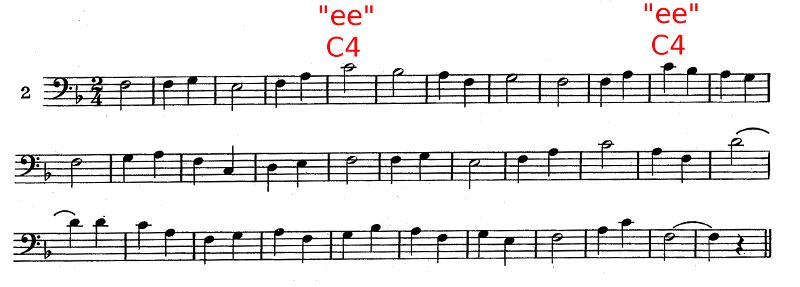
Ninth Bassoon Lesson, Part 2
Comments on bassoon pedagogy and the presentation of teaching in the 200 BDP videos. Application of vowels or voicing to studies. by A Tune a Day and Rubank. By Terry B. Ewell. BDP#196. www.2reed.net/bdp.
<Intro
Music: “Home Sweet Home” from A Tune a Day,
lesson 29 number 6.>
Well, I am grateful to recognize
that this video marks the 200th video that I have made in the Bassoon
Digital Professor Series. I don’t know if there will be another hundred coming
because in these first two hundred I really have set out my pedagogy, my
approach to teaching the bassoon.
I want to bring to your attention
that there is a website, www.2reed.net/bdp,
that has all of my materials and videos. It lays out the videos in a suggested
order for your study.
Primarily the twenty or so videos
that are in this beginning bassoonist series followed by the over fifty videos
that are in the Weissenborn advanced fifty studies series provide the
comprehension overview of my teaching methods. I hope that you will view those
in order and that you will have an idea of what I consider fundamental for
playing the bassoon. I think that you will benefit from that.
Now, let’s move on to the studies
in this lesson.
Henry Paine, page 13, shows
vowels for this study. See the time signature in this study has a “C” and that
means Common Time or 4/4 time. He writes there, “Slowly—with full tone; think
Ah.” So it is that “ah” vowel that we mostly use on the bassoon for that fuller
tone. This is particularly for the lower notes given in this study.
<Example: Paine, p. 13>

Now I particularly have the
sensation as I am going lower on the bassoon in this study that the vowel
changes in my mouth and becomes much more that “ah” sound. None of these notes
necessarily really reaches an “ee,” but it moves in that direction (for E3).
Now in the next study, however,
where we have some C4s and Bb3s, I do use the “ee” vowel. These notes tend to be
quite flat. So let’s look at the Rubank lesson 9, number 2. I am just going to
play for you the first few measures here. The opening note, that F, has more of
an “ah” vowel. In measure 4 as I move up to the C natural, I am quickly moving
from “ah” up to the “ee” vowel position with my tongue for the C4 and the Bb3
following.
<Example: Rubank lesson 9 #2>

It is quite
complicated playing the bassoon, isn’t it? You have to remember your flick keys,
who have to remember to take off the whisper key, you have to change the vowel
position, all of that. So take your time. Practice the techniques correctly
right from the beginning. Then you won’t have to waste your time later doing
that (correcting mistakes). So practice carefull flicking of the A3. Get up to
the C with a flick, this is the C4 in measure 5. Make sure that the vowel is an
“ee.” All of that has to happen.
Let’s look at a
wonderful melody here, “The Blue Bells of Scotland” from
A Tune a Day, page 26. Concentrate on
your vowels, your phrasing as you are playing this. Play with a beautiful sound.
There isn’t a dynamic given here so play it a good
mezzo forte, play with a singing
sound. I don’t think those numbers when I count, instead I think of pulses.
<Example:
A Tune a Day, p. 26>

<Closing
Music: “Home Sweet Home” from A Tune a Day,
lesson 29 number 6.>
Copyright (c) 2016 By Terry B. Ewell. All rights reserved.